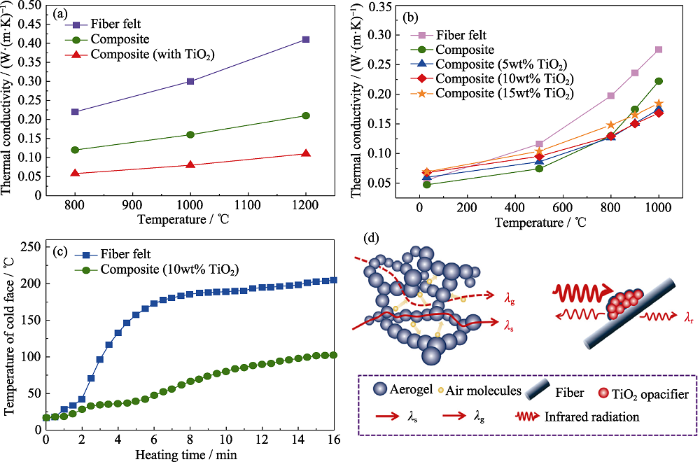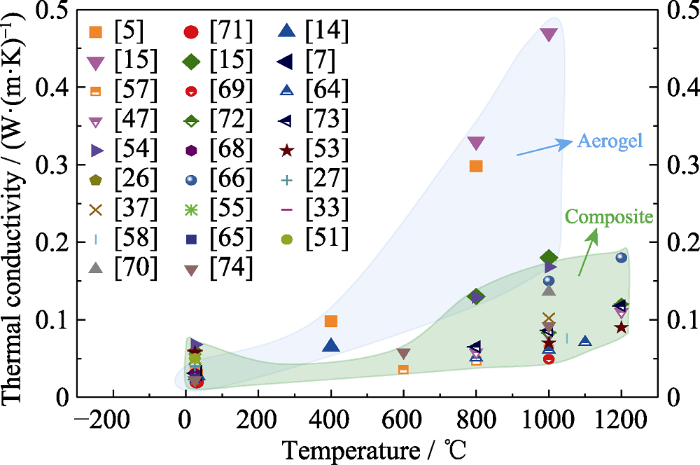随着航天飞行器不断向高马赫数和长航时的方向发展, 飞行器表面的气动加热环境更为恶劣[1], 对热防护系统的防隔热性能提出了极为苛刻的要求, 亟需轻质、耐更高温度(1000 ℃以上)、隔热性能更优异且具有较好力学性能的新型材料。在民用领域, 工业窑炉(水泥回转窑、钢铁高炉/转炉、陶瓷窑等, 工作温度200~2500 ℃)在总的能源消耗中占据很大比重, 采用传统的耐火砖、陶瓷纤维等作为保温材料, 热导率偏高, 造成了较高的能量耗散, 需要采用新型的高效隔热材料降低能源消耗。
气凝胶是一种由纳米尺度颗粒组成的高孔隙率和低密度材料, 其复杂的三维网络结构、纳米尺度的孔径显著抑制了固态和气态热传导, 因而具有极低的热导率[2]。陶瓷气凝胶(如氧化硅[3,4]、氧化铝[5,6,7]、氧化锆[8]、碳化硅[9]、氮化硼[10]等气凝胶)因具有良好的耐高温和隔热性能而受到广泛关注。氧化硅气凝胶是目前研究最为成熟的气凝胶材料, 已经作为高性能隔热材料得到了广泛应用[2], 但是氧化硅气凝胶在高温下会发生孔结构的破坏, 其短期使用温度上限一般不超过800 ℃[11,12]。相比于氧化硅气凝胶, 氧化铝气凝胶耐温性更高, 在1000 ℃时仍然能够保持纳米孔结构[5], 并具有很低的热导率(30 ℃时为0.029 W/(m·K)), 是目前有氧环境下耐温和隔热性能突出的气凝胶材料, 在航空航天、工业窑炉等温度更高的隔热领域具有很大的应用潜力。但是, 纯氧化铝气凝胶存在耐温性有待提升(最高使用温度一般不超过1000 ℃)、力学性能[5, 13]和高温隔热性能较差(对红外辐射的透过性很高, 在高温下热导率急剧上升[5,14-15])的问题, 是阻碍其在高温隔热领域实际应用的主要瓶颈。
自2008年以来, 研究人员先后发展了多种耐高温氧化铝气凝胶, 并在氧化铝气凝胶中引入力学增强相和红外遮光剂, 在提高氧化铝气凝胶耐温性、力学性能和高温隔热性能三方面开展了大量的研究工作, 本文对近年来这三方面的研究工作进行了详细总结, 对存在的问题进行了分析, 并对后续的研究方向提出了展望。
1 耐高温氧化铝气凝胶制备
如图1所示, 氧化铝气凝胶的制备过程一般包括溶胶-凝胶、老化、溶剂置换和干燥四个环节[16,17]。用于制备氧化铝溶胶的先驱体主要包括铝醇盐[5-6,18-19]、无机铝盐[13,20-22]、勃姆石粉[20]或勃姆石溶胶[23,24]。铝醇盐或无机铝盐通过水解反应形成具有Al-OH的中间体, 中间体通过Al-OH的缩合反应生成含Al-O-Al的溶胶颗粒, 颗粒间发生交联和团簇, 进一步生成三维网络结构并形成凝胶。铝醇盐活性很高, 极易水解和缩聚, 制备过程难以控制, 通常需要加入螯合剂(乙酰乙酸乙酯、乙酰丙酮等[6,18])形成具有Al-O-C的螯合物以降低其反应活性; 无机铝盐在水溶液中以水合离子形式存在, 通过环氧化物的开环反应, 消耗氢离子使pH缓慢上升, 生成Al-OH并逐步缩聚反应形成三维网络结构[13]; 勃姆石溶胶则是通过颗粒的絮凝作用形成凝胶[24]。在老化过程中, 凝胶网络结构的完整性和强度进一步提高; 凝胶孔隙内的水和其它副产物需要通过溶剂置换进行清除。为了避免凝胶孔内溶剂在干燥过程中产生毛细管力引起气凝胶的收缩、开裂和孔结构的破坏, 通常采用超临界态的乙醇[14,25-29]或二氧化碳[13,30]作为介质实现凝胶的干燥。相对于超临界干燥工艺, 冷冻干燥和常压干燥工艺制备的气凝胶收缩更大, 但成本更低, 也获得了关注和研究[31,32,33], 通常将这两种干燥方式得到的产物分别称为氧化铝冻凝胶和干凝胶。
图1
图1
氧化铝气凝胶的制备过程(R代表烷氧基, X代表氯离子等阴离子)
Fig. 1
Preparation of alumina aerogels (R refers to the alkoxyl group and X refers to the anion such as Cl-)
1.1 原位掺杂改性
在氧化铝气凝胶中引入硅元素是提高其耐温性的常用方法[7,18,34-39]。Horiuchi等[34]通过添加(2.5~ 10)wt%的氧化硅, 使氧化铝气凝胶的α相转变温度从1100 ℃升高至1400 ℃。均匀分布在氧化铝气凝胶网络结构中的硅, 抑制了高温下铝离子的表面扩散, 从而抑制了颗粒的烧结和α相转变, 经1300 ℃处理5 h后比表面积仍有80 m2/g。Osaki等[31]观察到添加10wt%氧化硅的氧化铝冻凝胶(冷冻干燥)经1200 ℃热处理5 h后, 仍然以γ-Al2O3相为主, 并认为热稳定性提高是由于硅离子占据了γ-Al2O3的四面体空位使总的空位数量减少, 从而抑制了高温下的晶格振动和α相转变。冯坚等[25]发现当氧化铝-氧化硅气凝胶中硅含量为(6.1~13.1)wt%时, 硅原子能够完全填充氧化铝的四面体空位, 此时其热稳定性明显高于纯氧化铝气凝胶, 1200 ℃时的比表面积为97~116 m2/g。Pakharukova等[18]则提出, 氧化硅的引入增加了氧化铝气凝胶的各向异性程度, 减少了颗粒间颈部接触的机率, 从而抑制了 α-Al2O3晶相的形核和晶粒长大。Peng等[39]发现含适量硅的氧化铝-氧化硅气凝胶的热稳定性显著高于纯氧化铝气凝胶(图 2(a, b)), 均匀分布在氧化铝气凝胶中的硅(图 2(c))抑制了铝原子的表面扩散和重排, 在高温下转化为莫来石相, 消耗了一部分可能发生α相转变的氧化铝, 同时减少了氧化铝颗粒间的颈部接触, 最终抑制了α相转变。
图2
图2
高温热处理后的氧化铝-氧化硅气凝胶[39]
Fig. 2
Alumina-silica aerogels after heat-treatment[39]
(a) Specific surface areas of aerogels with different molar ratios of Si; (b) TEM photos of the pristine alumina aerogel (AA-1300) and alumina-silica aerogel calcined at 1300 ℃(ASA81-1300); (c) Distribution and atomic ratio of Si and Al in the aerogel with a theoretical Si/Al molar ratio of 0.125:1 (Bars representing 20 nm; the red and green color representing Si and Al, respectively)
1200 ℃时仍保持过渡相(δ-Al2O3), 并在高温下氧化钇和氧化铝形成了固溶体, 降低了铝离子的扩散速率, 从而抑制了气凝胶的烧结和相变。孙雪峰等[45]发现添加适量锶的氧化铝气凝胶经1200 ℃处理后的比表面积达到122 m2/g, 认为热稳定性的提高是由于SrO抑制了气凝胶的烧结, 而高温下生成的SrO·6Al2O3抑制了α相转变。
1.2 沉积改性
Zu等[47]采用仲丁醇铝(ASB)和正硅酸乙酯(TEOS)溶胶多次浸泡氧化铝凝胶, 借助化学沉积方式(图 3(a))使凝胶颗粒增大、网络结构增强, 并在表面生成氧化硅颗粒, 显著提高了氧化铝气凝胶抵抗烧结和相转变的能力, 经1300 ℃处理2 h后线性收缩仅为4%(图3(b)), 比表面积为139 m2/g, 仍保持为片叶状(图3(c))。利用相似的原理, Zu等[7]以ASB和TEOS溶胶作为改性液, 在超临界干燥过程中实现改性, 增大了氧化铝气凝胶颗粒的尺寸和骨架强度, 减少了颗粒间的颈部接触点; 进一步采用六甲基二硅氮烷与气凝胶颗粒表面反应引入Si-CH3基团在高温下转变成SiO2颗粒, 能够抑制气凝胶的烧结和相转变。制备的改性氧化铝气凝胶经1300 ℃处理2 h后, 线性收缩仅为5%, 比表面积高达125 m2/g。
图3
1.3 其它方法
在溶胶制备过程中加入异质元素先驱体, 可获得掺杂元素分布均匀的氧化铝气凝胶。通过调控铝源和异质元素先驱体的比例, 能够较为精确地设计元素掺杂量。适量、均匀的掺杂元素能够有效地抑制氧化铝的烧结和相变, 提高其热稳定性, 其中掺杂硅元素的改善效果最为显著。通过沉积改性方法增强氧化铝凝胶的骨架及引入氧化硅颗粒, 能够显著提高氧化铝气凝胶的耐温性, 但是在制备过程中通常需要进行多次溶剂置换和改性, 并消耗大量的改性液, 其制备工艺的简易性和成本方面仍有待进一步优化。有机链改性方法对氧化铝气凝胶热稳定性的提高比较有限; 炭隔离相的方法是在氧化铝气凝胶网络结构中引入炭涂层, 其在高温有氧条件下会发生氧化, 丧失其隔离相的作用。因此, 在气凝胶中原位掺杂硅元素是目前较好的制备耐高温氧化铝气凝胶的途径。
2 氧化铝气凝胶复合材料的制备及力学性能
图4
为了改善纯氧化铝气凝胶的力学性能, 研究者通常需要引入力学增强相制备氧化铝气凝胶复合材料, 常见的增强相包括晶须、颗粒或纤维等一类强韧的材料。由图5可见, 氧化铝气凝胶复合材料的制备过程主要涉及到液(氧化铝溶胶)固(增强相)两相的复合, 增强相的种类不同, 其与氧化铝气凝胶的复合方式也有较大差异。
图5
2.1 晶须或颗粒增强
由于晶须或颗粒的尺寸较小, 研究人员通常采用机械搅拌、超声振动等手段将其分散在氧化铝溶胶中, 进一步制备出氧化铝气凝胶复合材料。Mizushima等[50]通过加入乙酰乙酸乙酯(螯合剂)调控氧化铝溶胶的活性, 在高速搅拌和超声分散条件下使碳化硅晶须分散在溶胶中, 采用超临界干燥制备了碳化硅晶须增强氧化铝气凝胶复合材料。Hou等[27]将硼酸铝晶须加入至氧化铝-氧化硅溶胶中搅拌后, 通过升温使其快速凝胶, 再经超临界干燥制备了氧化铝-氧化硅气凝胶复合材料(图6(a, b))。在压缩载荷下, 复合材料中的晶须通过桥连和拔出机制消耗能量, 因此具有较高的压缩强度(图6(c))。隋超[51]通过引入纤维素晶须改善了氧化铝气凝胶的力学性能, 当纤维素含量较高时, 复合材料具有明显的柔性。曹凤朝[52]将凹凸棒土颗粒进行预分散形成悬浮液后再加入至氧化铝溶胶中, 获得了颗粒增强氧化铝气凝胶复合材料, 复合材料的压缩强度很高(74.5 MPa), 但密度偏大(0.8 g/cm3)。
图6
由于重力作用, 晶须或颗粒在氧化铝溶胶中容易产生沉降而导致制备的复合材料不均匀, 因此, 掌握合适的添加时机和工艺参数是制备过程的关键。
2.2 多孔骨架增强
引入增强相的另外一种方式, 是将陶瓷纤维制备成本身具有一定强度的多孔骨架再浸渍氧化铝溶胶。用于制备多孔骨架的纤维主要包括莫来石、氧化锆和石英纤维等。
孙晶晶等[53]以莫来石纤维为原料, 经高温烧结得到多孔骨架(隔热瓦), 再浸渍氧化铝溶胶, 采用乙醇超临界干燥制备得到常温热导率(热流计法)为0.058 W/(m·K)的隔热瓦复合氧化铝气凝胶材料, 其压缩和拉伸强度分别达到1.48、0.58 MPa, 经1400 ℃处理0.5 h后厚度收缩率为2%。
图7
图8
Zou等[54]采用冷冻干燥和烧结工艺得到莫来石纤维多孔骨架, 再浸渍氧化铝-氧化硅溶胶, 经超临界干燥后得到密度为0.227~0.304 g/cm3的气凝胶复合材料。复合材料的压缩应力(3%应变)和杨氏模量分别为0.02~0.11 MPa、0.78~3.58 MPa, 相比莫来石纤维毡(杨氏模量为0.04 MPa)强度显著提高。在压缩载荷下, 复合材料经历了线性(0~8%应变)、屈服((8~30)%应变)和密实化(应变大于30%)三个变形阶段。
多孔骨架本身具有一定的强度和较低的热导率, 因此其对于氧化铝气凝胶是一种合适的增强体, 能够制备出力学性能(如压缩强度)较好的复合材料。但是, 在多孔骨架的制备过程中, 通常需要使用粘接剂将纤维结合在一起, 一定程度上增加了纤维骨架之间的固体热传导。如何用更为简单的工艺制备多孔骨架并减少骨架连接处的热桥效应, 以降低多孔骨架本身的热导率, 是未来的重要研究内容。
2.3 纤维增强
采用纤维与氧化铝溶胶直接复合是制备氧化铝气凝胶复合材料的常用方法。根据长径比, 纤维可分为短纤维和长纤维两种。其中, 短纤维一般以类似于晶须的引入方式, 通过机械搅拌分散在氧化铝溶胶中; 长纤维内部含有大量孔隙, 氧化铝溶胶可通过浸渍过程渗入其中。
图9
图9
纤维增强氧化铝(氧化铝-氧化硅)气凝胶复合材料[55,56,57]
Fig. 9
Fiber reinforced alumina (alumina-silica) aerogel composites[55,56,57]
(a) Influence of mass fraction of fibers on mechanical properties[55]; (b) Behavior of composites under compressive and bending loadings[56]; (c) Morphology and (d) bending/tensile strengths of composites with different fiber densities[57]
研究结果表明, 陶瓷纤维毡本身具有良好的整体性、成型性和柔韧性, 作为增强相与氧化铝气凝胶复合后, 能够显著提高其力学性能(产生韧性); 相比于其它的增强相的复合方式, 以纤维毡直接浸渍氧化铝溶胶的工艺相对更为简单。因此, 以陶瓷纤维毡为增强相制备氧化铝气凝胶复合材料是当前以及后续的一个重要研究方向, 具有很大的应用潜力。
3 氧化铝气凝胶复合材料的隔热性能
纯氧化铝气凝胶具有很低的密度和纳米孔结构, 显著抑制了固态和气态热传导, 因而常温热导率较低, 但在高温下的红外辐射透过率很高[59], 必须引入能够抑制红外辐射的物质(如纤维和遮光剂)以降低其高温热导率。
3.1 纤维对复合材料隔热性能的影响
图10
图11
Wang等[65]以石英纤维织物作为增强相制备了氧化铝-氧化硅气凝胶复合材料, 并采用厚度为25 mm的复合材料进行了石英灯单面加热(热面温度1200 ℃, 加热25 min)试验, 试验结束时的冷面温度为733 ℃。
3.2 遮光剂对复合材料隔热性能的影响
由于纤维对红外辐射的抑制作用有限, 研究人员在氧化铝气凝胶复合材料中引入耐高温的遮光剂组分(如氧化钛、氧化锆、碳化硅等), 以提高其对红外辐射波的散射和吸收能力, 进一步降低高温热导率。
图12
近年来有研究报导了引入氧化钛颗粒对氧化铝气凝胶复合材料结构和性能的影响规律。Zu等[47]将氧化钛颗粒(直径为250 nm左右)分散到氧化铝溶胶中, 再浸渍莫来石纤维毡得到氧化铝气凝胶复合材料, 其高温热导率(水流量平板法)显著低于莫来石纤维毡以及不含氧化钛的复合材料(图13(a))。Zou等[54]通过冷冻干燥和烧结工艺将亚微米尺寸的氧化钛颗粒分散于莫来石纤维多孔骨架中, 再浸渍氧化铝-氧化硅溶胶, 制备得到氧化铝-氧化硅气凝胶复合材料。适量氧化钛的引入使复合材料在800 ℃以上的热导率下降(图13(b))。在丁烷火焰加热下, 复合材料的冷面温度显著低于莫来石纤维毡(图13(c))。亚微米尺寸的氧化钛颗粒对800~1200 ℃下的红外辐射波具有显著的散射和吸收效应, 从而大幅抑制了辐射传热(图13(d))。
图13
图13
引入氧化钛的莫来石纤维增强氧化铝气凝胶复合材料的高温热导率(a)[47], 不同氧化钛含量复合材料的高温热导率(b)[54], 含氧化钛的复合材料(厚度为20 mm)在丁烷火焰加热(1300 ℃, 15 min)下的冷面温度(c)[54], 复合材料的传热机制(λs、λg分别为固态、气态热导率)(d)[54]
Fig. 13
The mullite fiber felt reinforced alumina-silica aerogel composite doped with TiO2 (a) High-temperature thermal conductivity[47]; (b) High-temperature thermal conductivity of composites with different content of TiO2[54]; (c) Temperature (cold-face) of the composite (doped with 10wt% TiO2) fired by the flame of butane spray gun at 1300 ℃ for 15 min[54]; (d) Heat transfer mechanism of the composite (λs and λg refering to solid and gaseous thermal conductivity, respectively)[54]
图14
3.3 复合材料的典型热导率
由图15可知, 纯氧化铝气凝胶的热导率随温度升高而急剧上升, 其1000 ℃热导率可达常温热导率的10倍以上。引入纤维等增强相和遮光剂之后制备的氧化铝气凝胶复合材料的常温热导率(0.022~ 0.068 W/(m·K))有所上升, 主要原因是这些组分一定程度上增加了固态传热。相比于纯氧化铝气凝胶, 复合材料的高温热导率显著下降, 综合隔热性能大幅提高。综上所述, 目前制备的氧化铝气凝胶复合材料的常温热导率仍然偏高, 其高温热导率随温度升高的趋势仍然较为明显, 1200 ℃热导率上升至0.09 W/(m·K)以上。但是, 通过引入遮光剂, 氧化铝气凝胶复合材料在1000 ℃时的热导率可降低至0.049 W/(m·K)[69], 表明复合材料的热导率还有较大的优化空间。后续的工作中, 需要深入研究复合材料各组分间的协同传热机制, 调整氧化铝气凝胶的孔结构和体积分数、遮光剂的种类和体积分数等关键参数, 以进一步降低氧化铝气凝胶复合材料在整个温度范围内的热导率。
图15
图15
典型的纯氧化铝气凝胶及其隔热复合材料的热导率值
Fig. 15
Thermal conductivity of typical pristine alumina aerogels and alumina aerogel insulation composites
4 总结与展望
本文对耐高温氧化铝气凝胶的制备、氧化铝气凝胶隔热复合材料的制备及性能等方面的最新研究进展进行了总结。通过元素掺杂、沉积改性等方法, 氧化铝气凝胶的热稳定性得到了明显改善; 在氧化铝气凝胶中引入纤维等增强相能够大幅提高其力学性能; 纤维和遮光剂的协同作用, 提高了氧化铝气凝胶抑制红外辐射的能力, 显著降低了高温热导率。针对目前存在的问题, 后续可能的研究方向包括:
2)氧化铝气凝胶复合材料的隔热性能优化。目前, 氧化铝气凝胶复合材料在整个温度范围的热导率仍然相对偏高。首先需要进一步调控氧化铝气凝胶的密度、颗粒尺寸/形貌, 使其具有合适的密度和小的孔径, 以进一步降低复合材料的气态热导率。另一方面, 需要采用更为简单、高效的方法, 将合适种类、尺寸和含量的遮光剂均匀引入至氧化铝气凝胶复合材料中, 以进一步降低高温热导率。
3)复合材料在高温下结构和性能的演化。高温环境中, 复合材料中的氧化铝气凝胶和增强相之间会发生相互作用, 将对复合材料的结构和性能产生显著影响。主要的研究方式有两种: 将复合材料热处理后进行尺寸、微观形貌、晶型、性能等的表征[75]; 在加热条件下实时观察复合材料尺寸、微观结构和性能的变化。
随着技术的不断发展和完善, 氧化铝气凝胶复合材料将在高温隔热领域发挥其优势并逐步实现应用。
参考文献
Thermal protection systems for space vehicles: a review on technology development, current challenges and future prospects
Preparation of silica aerogels with high temperature resistance and low thermal conductivity by monodispersed silica sol
In situ synjournal of biomimetic silica nanofibrous aerogels with temperature-invariant superelasticity over one million compressions
Synthesis of high porosity, monolithic alumina aerogels
Nanoengineering super heat-resistant, strong alumina aeroegels
Highly thermally stable zirconia/ silica composite aerogels prepared by supercritical deposition
Ultralight, recoverable, and high temperature-resistant SiC nanowire aerogel
Double-negative-index ceramic aerogels for thermal superinsulation
Nanostructure evolution of silica aerogels under rapid heating from 600 ℃ to 1300 ℃ via in-situ TEM observation
Synthesis of high-surface-area alumina aerogels without the use of alkoxide precursors
Preparation and characterization of monolithic alumina aerogels
Trimethylethoxysilane- modified super heat-resistant alumina aerogels for high-temperature thermal insulation and adsorption applications
Structure and morphology evolution of silica-modified pseudoboehmite aerogels during heat treatment
Investigation of the effect of alumina-aerogel support on the CO2 capture performance of K2CO3
Optimization of alumina and aluminosilicate aerogel structure for high-temperature performance
Luminescent alumina-based aerogels modified with tris(8-hydroxyquinolinato)aluminum
Fabrication of Al2O3 aerogel-SiO2 fiber composite with enhanced thermal insulation and high heat resistance
Mesoporous silica-alumina aerogels with high thermal pore stability through hybrid Sol-Gel route followed by subcritical drying
Ultralow- density, transparent, superamphiphobic boehmite nanofiber aerogels and their alumina derivatives
Novel Al2O3-SiO2 composite aerogels with high specific surface area at elevated temperatures with different alumina/silica molar ratios prepared by a non- alkoxide Sol-Gel method
Novel whisker-reinforced Al2O3- SiO2 aerogel composites with ultra-low thermal conductivity
Facile one-step precursor- to-aerogel synthesis of silica-doped alumina aerogels with high specific surface area at elevated temperatures
Utilization of alumina aerogel as high surface area support for the fabrication of oxygen carriers in the chemical looping combustion process
Preparation of heat-resistant alumina aerogels
Silica-doped alumina cryogels with high thermal stability
Synthesis of an alumina enriched Al2O3-SiO2 aerogel: reinforcement and ambient pressure drying
Quartz fiber reinforced Al2O3-SiO2 aerogel composite with highly thermal stability by ambient pressure drying
Maintenance of large surface area of alumina heated at elevated temperatures above 1300 ℃ by preparing silica-containing pseudoboehmite aerogel
Influence of Ti addition on boehmite-derived aluminum silicate aerogels: structure and propeties
Synthesis of a novel Al2O3-SiO2 composite aerogel with high specific surface area at elevated temperatures using inexpensive inorganic salt of aluminum
Novel Al2O3-SiO2 aerogel/porous zirconia composite with ultralow thermal conductivity
结构强健的 Al2O3-SiO2气凝胶的制备及可重复使用性能
A facile method to fabricate monolithic alumina-silica aerogels with high surface areas and good mechanical properties
Effect of La addition on thermal microstructural evolution of macroporous alumina monolith prepared from ionic precursors
Rapid preparation process, structure and thermal stability of lanthanum doped alumina aerogels with a high specific surface area
Investigation of the effect of lanthanum oxide on the thermal stability of alumina aerogel
Thermal stability of alumina aerogel doped with yttrium oxide, use as a catalyst support for the thermocatalytic cracking (TCC) process: an investigation of its textural and structural properties
One-step synthesis of monolithic micro-nano yttria stabilized ZrO2-Al2O3 composite aerogel
Robust, highly thermally stable, core-shell nanostructured metal oxide aerogels as high-temperature thermal superinsulators, adsorbents, and catalyst
Preparation and properties of alumina-organic compound aerogels
Stabilizing effect of the carbon shell on phase transformation of the nanocrystalline alumina particles
Preparation of an alumina aerogel with SiC whisker inclusion
Opacifier embedded and fiber reinforced alumina-based aerogel composites for ultra-high temperature thermal insulation
Mechanical and thermal conductive properties of fiber-reinforced silica-alumina aerogels
High-temperature insulation property of opacifier-doped Al2O3-SiO2 aerogel/mullite fiber composites
Thermal transport in nano-porous insulation of aerogel: factors, models and outlook
Conduction and radiation heat transfer in high-porosity fiber thermal insulation
Radiative properties and heat transfer characteristics of fiber-loaded silica aerogel composites for thermal insulation
The influence of gaseous heat conduction to the effective thermal conductivity of nano-porous materials
Synthesis of fibre reinforced Al2O3-SiO2 aerogel composite with high density uniformity via a facile high-pressure impregnation approach
Preparation and thermal stability of quartz fiber reinforced silicon doped aluminum aerogel composites
Carbon-fiber felt reinforced carbon/alumina aerogel composite fabricated with high strength and low thermal conductivity
Porous carbon-bonded carbon fiber composites impregnated with SiO2-Al2O3 aerogel with enhanced thermal insulation and mechanical properties
Infrared-opacified Al2O3-SiO2 aerogel composites reinforced by SiC-coated mullite fibers for thermal insulations
Mechanical strengths and thermal properties of titania-doped alumina aerogels and the application as high-temperature thermal insulator
氧化铝气凝胶隔热材料的制备和热学性能
耐高温Al2O3基气凝胶的制备和特性研究
Highly thermally stable alumina- based aerogels modified by partially hydrolyzed aluminum tri-sec-butoxide
氧化硅气凝胶与氧化铝气凝胶的性能对比


















